This post may contain affiliate links. Please read our disclosure policy.
Learn more about taro roots! What it is, how to cook it, its health benefits, plus a round-up of recipes that make use of this uncommon root vegetable!
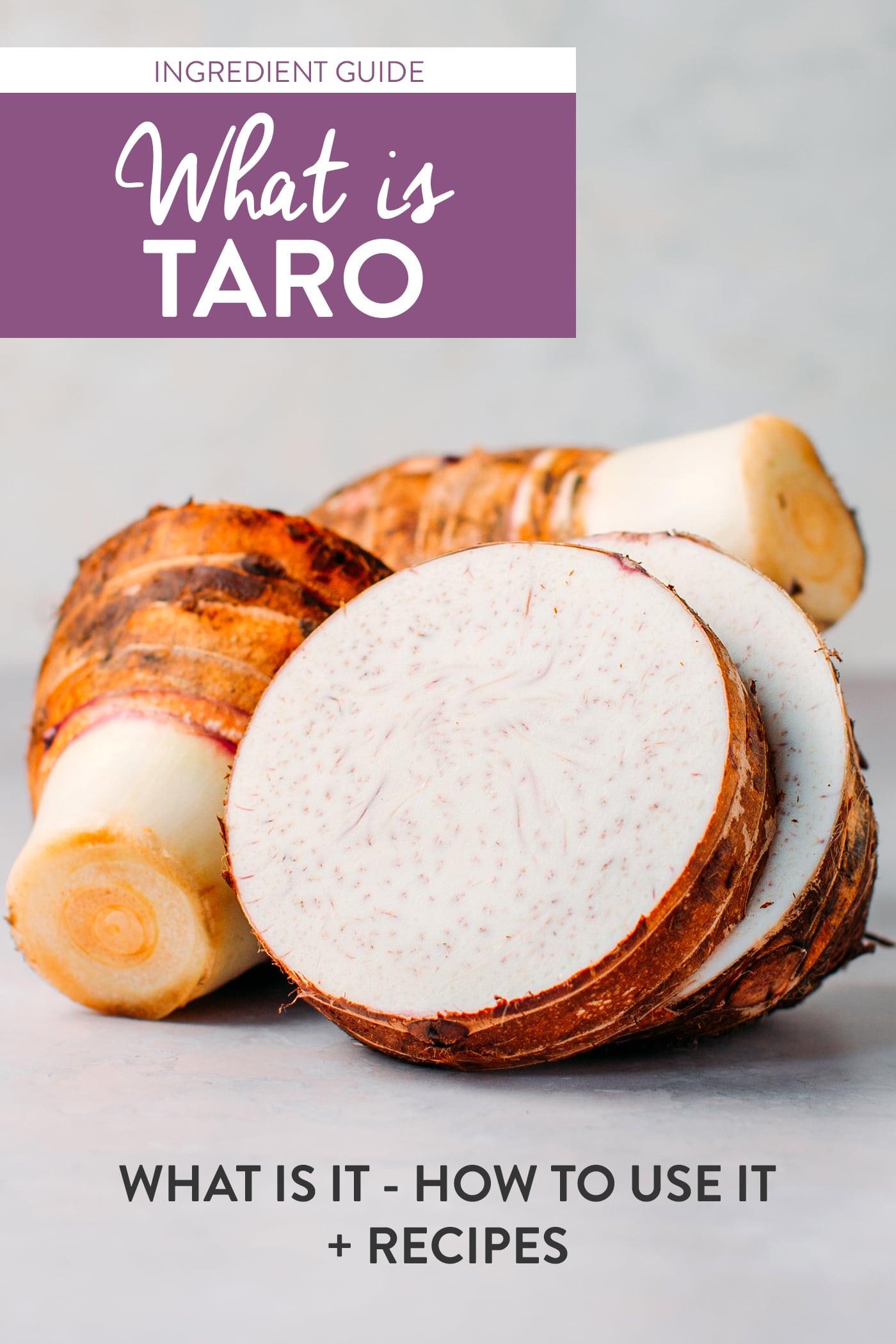
If you ever feel intimidated by this vegetable, don’t worry! We are teaching all about it here, plus share a few recipe ideas!
📘 What is Taro?
Taro, scientifically known as Colocasia esculenta, is a tropical plant that is grown mainly for its edible tubers in Africa, Oceania, and South Asia (just like sweet potatoes and yams). While its corms are primarily used for cooking, its leaves are also edible. Moreover, it is said to be one of the earliest cultivated plants on Earth!
This starchy root vegetable was originally grown in Asia but has now become popular in many countries around the world. It has a brown outer skin and a white flesh with purple spots. Once cooked, it tastes mildly sweet and has a texture similar to that of a potato.
📓 Types of Taro
There are many varieties of it, but only two very different types:
- Small Taro Roots – Also called Eddoe, this variety consists of small tubers of about 150-300 grams. Its skin is light brown with some kind of threads, resembling the shell of a coconut. It has a white flesh and an earthy flavor.
- Large Taro Roots – This type of taro is usually more elongated and heavier (1-2 kg) compared to Eddoe. Its flesh is white as well but with light purple specks. It is sweeter and nuttier. I personally have a preference for this variety.
Are eddoe and taro interchangeable? Overall yes, they can be used interchangeably in most recipes. However, when used in dessert recipes, I would recommend going with the larger taro roots, which are sweeter, more buttery, and less starchy.
🥔 How to Pick a Good One?
1. Overall Appearance
It can be difficult to judge whether a taro is fresh or not. However, you can check the outer skin. If there is a lot of wet soil, it means it has just been dug up. I also recommend paying attention to the outer skin to see if there are any spots of mold.
2. Weight
Weighting 2 taro roots of the same size by holding one in each hand is also an effective way to pick a good one. If the taro root is heavy, it means it has a lot of water inside. Therefore, once cooked, it will usually be tasteless. A good taro will have a buttery and nutty flavor once cooked.
3. Flesh
Taro can also be found cut in halves in grocery stores, especially when the roots are very large. If this is the case, look at its flesh. If the specks have a light purple color (see the image below), it means that the taro is good. Otherwise, the specks are brown; it means the taro is usually not good.

🥣 How to Cook It
Taro can be used the same way you would use regular white potatoes. It can be sautéed, steamed, boiled, or deep-fried.
Washing and Preparing Taro
If your taro has a lot of soil around it, run it under cold water to wash it. Drain well and pat it dry.
Next, cut it: I recommend starting by slicing it crosswise into 1-inch wedges and then peeling the skin using a sharp knife. I find this way easier compared to peeling it whole.

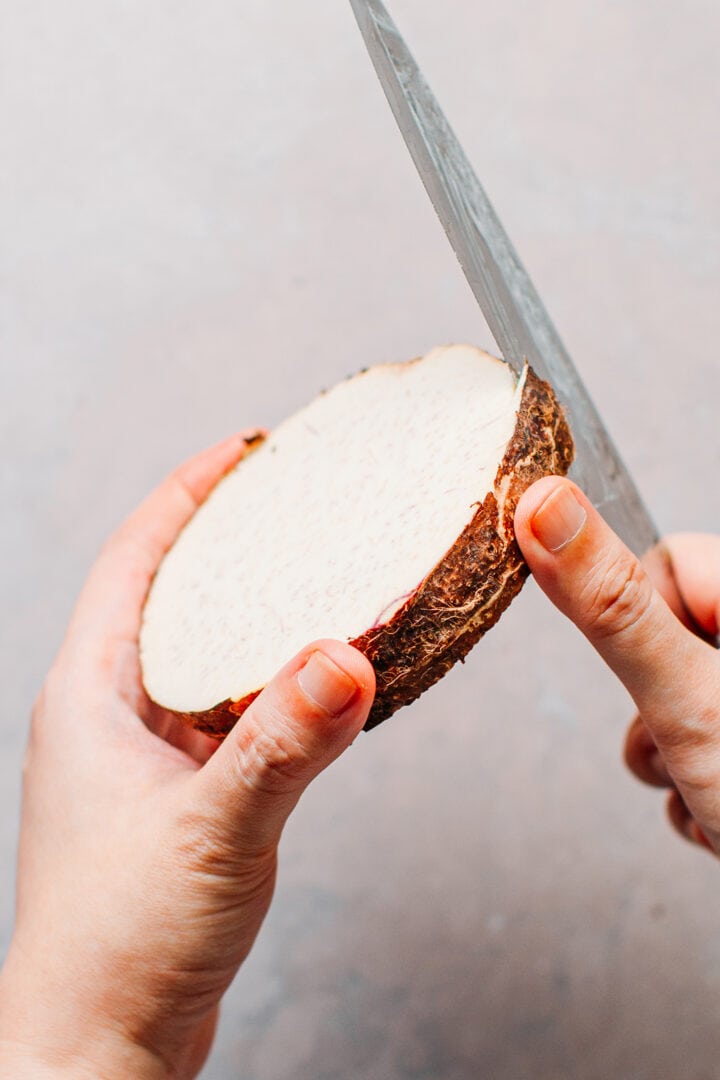
Once your taro is peeled and cut into the desired shape, soak it in salted water for about 15 minutes and then drain. This step will help remove some of the starch.

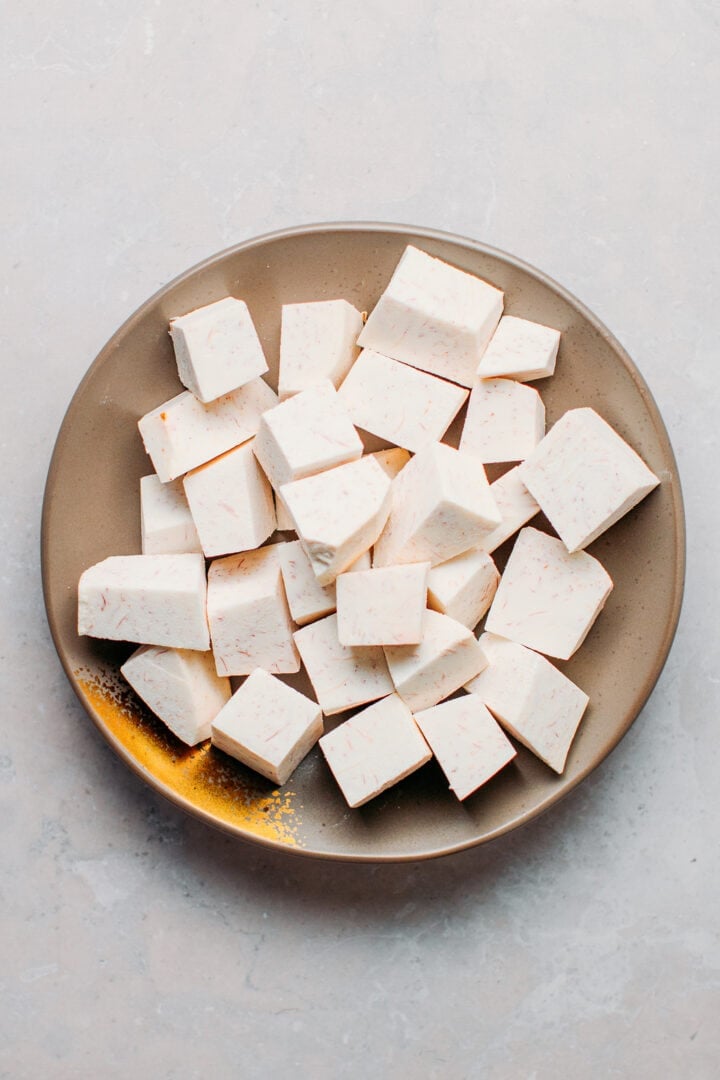
Steaming
Once your taro is peeled and has soaked, drain it and place it in a bamboo steamer basket or regular steamer. You can then steam it for about 15 minutes or until its flesh is tender.
Boiling
Put the diced taro in a large pot and cover with water to fully submerge it. Bring to a boil and let simmer for 15-20 minutes or until it is soft. Keep an eye on it, as you don’t want to overcook it. It would become too soft and watery.
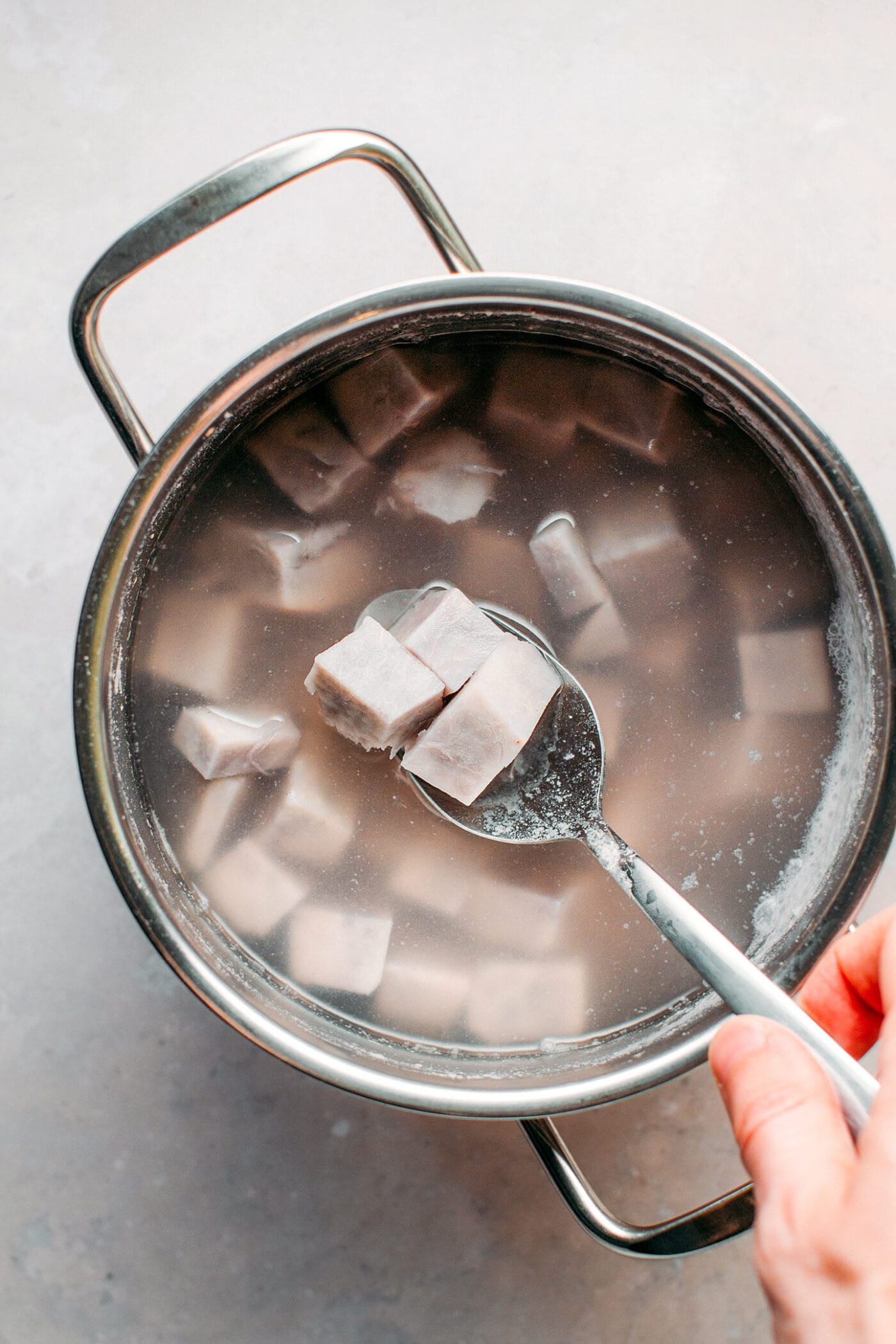
Frying
If you want crispy on the outside and tender on the inside taro, frying is the way to go! To make taro fries:
- Peel, wash, and cut taros into about 3-inch (6-8 cm) long strips with about 1/2-inch (1 cm) in width. Soak them in a bowl of cold water mixed with a generous pinch of salt and a squeeze of lemon juice for about 15 minutes. Then rinse several times and drain well.
- Heat a sufficient amount of cooking oil in a deep pan. Once the oil is hot, put the taros into the pan and fry on medium heat. If the oil is too hot, your fries might burn before the inside is fully cooked.
- When the taro fries are golden brown on all sides, remove them from the oil using a slotted spoon and place them on a plate lined with kitchen paper towels. Enjoy immediately; otherwise, the fries will get softer after a few hours.
Feel free to check out this more in-depth recipe on how to make taro fries.
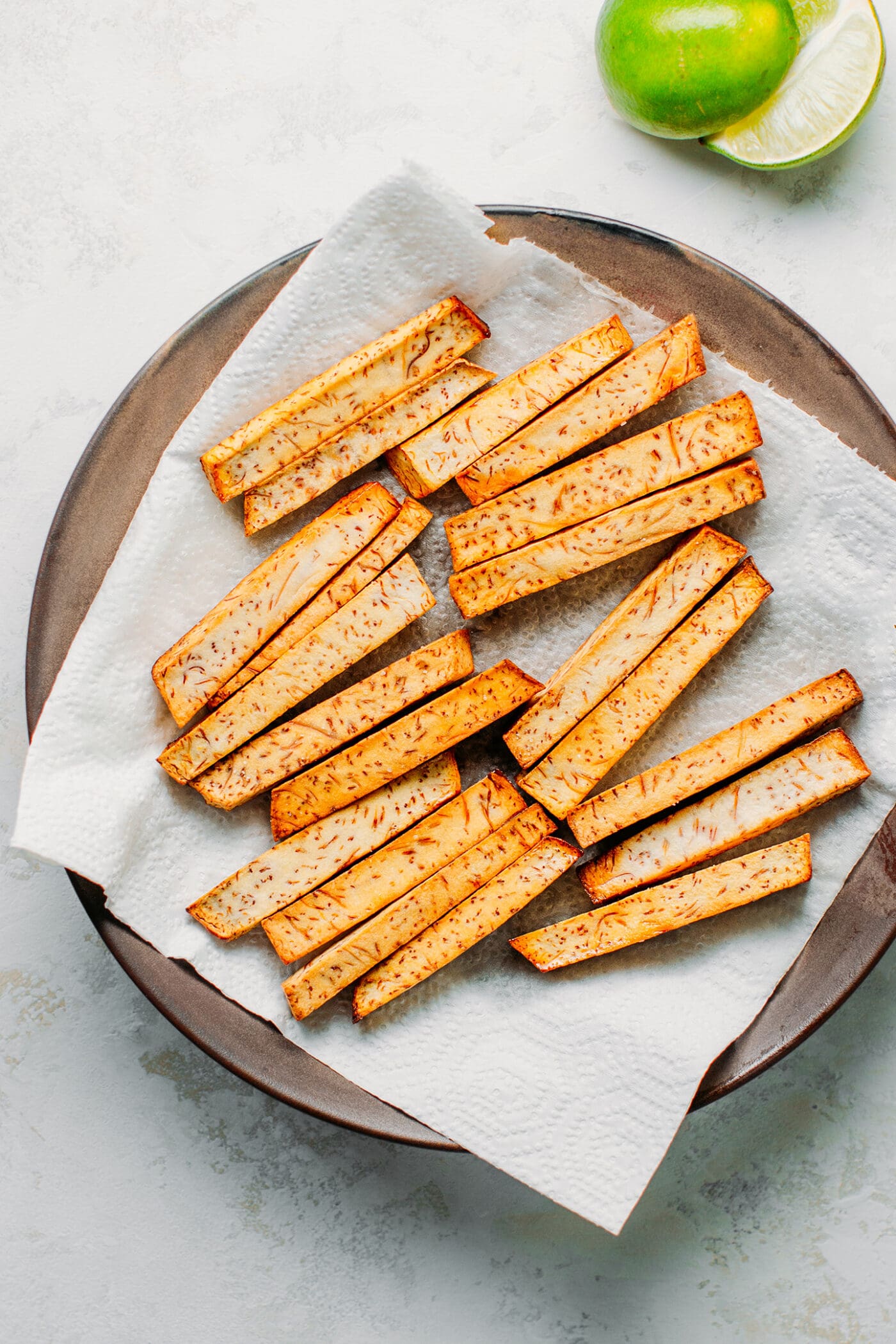
📙 Nutritional Value of Taro
Compared to white potatoes, taro is a little bit higher in calories as it has a denser texture. Per 100g of cooked taro:
- 142 calories
- 0.1g of fat
- 34.6g of carbohydrates
- 5.1g of fiber
- 0.5g of protein
🩺 Health Benefits of Taro
Taro is very rich in nutrients. One portion of it provides 1/3 of your daily recommended amount of manganese, which is good for metabolism, bones, and preventing blood clotting.
It also contains many vitamins that are good for the eyes, skin, circulatory, and immune systems.
Moreover, taro roots also bring other health benefits such as: improving digestion, stabilizing blood sugar, reducing your risk of diabetes, preventing your risk of heart disease, preventing cramps, etc.
📔 How to Store Taro
- For Whole Taro
The best way to store whole taro roots is to keep them in a cool and dry place (just like potatoes). Do not put taro in the refrigerator, or it will soften and quickly rot because of the humidity.
- For Peeled and Diced Taro
Simply transfer diced taro to an airtight container and store it in the refrigerator. It will keep for 3-4 days in the refrigerator. In the freezer, they can be stored for even longer, about 10 days.
🍲 Taro Recipes




Taro can be used to make both salty and sweet recipes. Here is a selection of plant-based taro recipes:
- Easy Vegan Egg Rolls: These easy vegan egg rolls are super crispy on the outside and tender on the inside. Served with a spicy and garlicky dipping sauce! Better than takeout!
- Creamy Taro Milk: Learn how to make delicious taro milk tea at home! Prepared from scratch with just 5 ingredients, this nutty and creamy drink is vegan and 100% natural!
- Taro Fries: Learn how to make taro fries! Crispy on the outside and tender on the inside, these taro fries come with a zesty cilantro mayo. Only 5 ingredients and 45 minutes are required!
- Vietnamese Curry: Hearty and flavorful one-pot Vietnamese curry! Infused with aromatics like lemongrass, ginger, and garlic, and loaded with eggplant, taro, carrots, tofu, and mushrooms!
- Taro Fritters: Perfectly crispy fritters made with taro roots, carrots, garlic, and green onions. Served with a sweet chili sauce!
You can also use taro in stews and soups. It will soak up the flavors of the broth!
💬 FAQ
As you can see in the photos, taro just has a very light and subtle purple color with some darker specks. It gets a darker shade of purple once cooked, especially when steamed.
Taro powder refers to cooked taro that has been dried and ground into a powder. Do not confuse natural taro powder with taro milk powder, which contains flavorings, sugar, and colorings. Sometimes, ube powder which has a deep purple color, is sold as “taro powder.” However, ube powder is made from a variety of purple yams.
Taro can be grown all year round in frost-free weather conditions and can be found year-round as well in most produce stores.
Taro can be grown all year round in frost-free weather conditions and can be found year-round as well in most produce stores.
Taro should never be eaten raw, as it would be toxic. It contains a chemical compound known as calcium oxalate, which can damage kidneys. Worry not. Once cooked, taro is completely safe to eat!
Taro has a milder flavor compared to potatoes. It is just slightly sweeter and a bit more earthy.
While taro and ube are both root vegetables, they are very different. Ube is a type of purple sweet potato. It is much sweeter and has a very bright purple flesh.
I hope you enjoyed this guide on taro and that you will give this root vegetable a try if you haven’t yet!
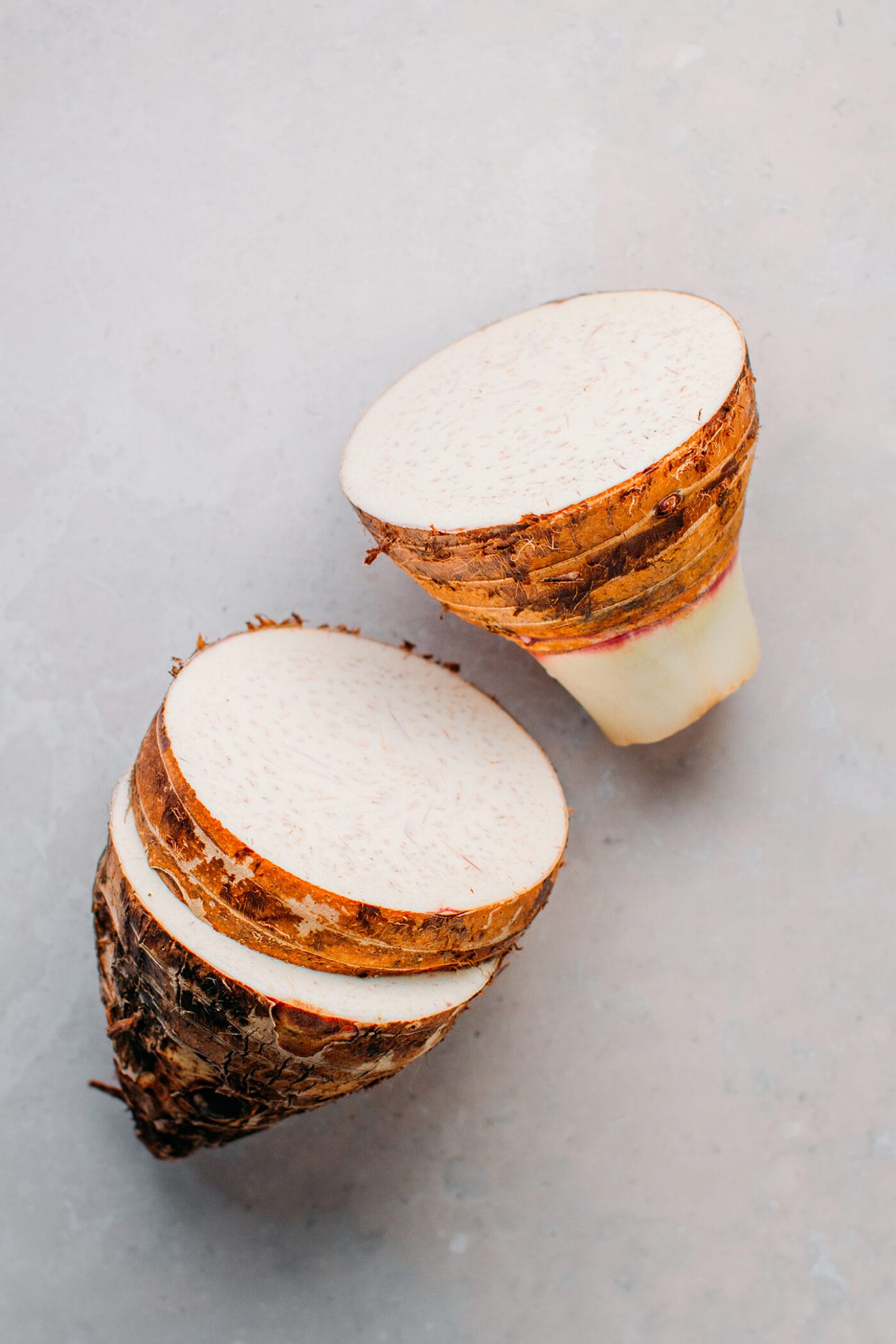

What is Taro (And How to Cook It)
Ingredients
- 1 large taro root
- 2 cups oil if frying
Instructions
- Wash the taro: if your taro has a lot of soil around it, run it under cold water to wash it. Drain well and pat it dry using kitchen paper towels.
- Slice the taro: I recommend starting by slicing the taro crosswise into 1-inch wedges. Then, peel the skin using a sharp knife. This way is easier compared to peeling it whole. You can now cut the peeled taro into cubes or matchsticks.
- Soaking: Once your taro is peeled and cut into the desired shape, soak it in salted water for about 15 minutes and then drain. This step will help remove some of the starch.
- To cook the taro, you have different options: steaming, boiling, or frying.
Steaming
- Place the taro in a bamboo steamer basket, or regular steamer. Steam it for about 15 minutes or until its flesh is fork-tender.
Boiling
- Put the taro in a large pot and cover it with water to fully submerge it. Bring to a boil and let simmer for 15-20 minutes, or until the taro is soft. Keep an eye on it as you don't want to overcook it. It would become too soft and watery.
Frying
- Heat a sufficient amount of cooking oil in a deep pan. Once the oil is hot, put the taros into the hot oil and fry on medium heat. If the oil is too hot, your fries might burn before the inside is fully cooked.
- When the taro fries are golden brown on all sides, remove from the oil using a slotted spoon and place them on a plate lined with kitchen paper towels. Enjoy immediately with your favorite sauce!
Notes
How to Store Taro:
- For Whole Taro: The best way to store whole taro roots is to keep them in a cool and dry place (just like potatoes). Do not put taro in the refrigerator, or it will soften and quickly rot because of the humidity.
- For Peeled and Diced Taro: Simply transfer diced taro to an airtight container and store it in the refrigerator. Taro will keep for 3-4 days in the refrigerator. In the freezer, they can be stored for even longer, about 10 days.
Nutrition

About the Author
Thomas Pagot is the founder, photographer, and recipe developer behind Full of Plants. He created the blog in 2016 as a personal cookbook for vegan recipes. Through years of recipe development, Thomas has successfully grown Full of Plants into a trusted resource for plant-based recipes.

🧀 25 Mind-Blowing Vegan Cheese Recipes!
Sign up for the Full of Plants newsletter and you’ll get new recipes delivered by email weekly, PLUS your FREE 100-page printable eBook!

Sorry pl delete my comment Thanks for this i never had or use taro before btw cant wait to make your recipes soon for me love your recipes as always brightens up my day everyday after work
Thanks for this i never had and use taro before cant wait to make all recipes soon for me btw cant wait to make your other recipes soon for me love your recipes as always brightens up my day everyday after work
My favorite way to eat taro root is to bake just as one would bake a potato. Very delicious and easy to prep. I take a plastic scrubber and brush harshly to remove all the stringy outer brown “hair”. The scrubbed root will be smooth, yet, slightly natural bumps. That is just the nature of the root. Bake till you can give it a squeeze with hot mitt so you don’t get burnt. Take out of oven to eat. I usually put some butter or dribble some olive oil over the white flesh and maybe a pinch of salt. Absolutely delicious!
Baked taro sounds delicious! Thanks for sharing Marigael!
How long do u bake it for? What temperature please?
Great work! This is so interesting and informative. Where I live, we don’t use taro for cooking. So, except for the name and the shape, I knew little about it. Thank you so much for your hard work!!!
You are welcome Jane!